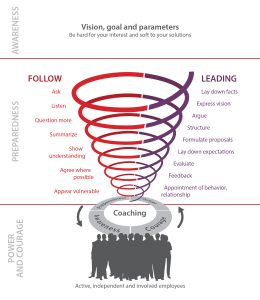Building on my last post, I would like to introduce a tool that can help leaders implement New Leadership’s two key principles: setting clear boundaries, and giving people autonomy within them.
One of the most intriguing management concepts of the past few years, Filip Vandendriessche’s Management Funnel is described in his book Leidinggeven Zonder Bevelen [Leadership Without Orders].
The Management Funnel Principles
The Management Funnel shows that you, as a manager, can especially use your power to clearly identify expected performance and create boundary conditions for your employees. Within these boundary conditions, you give your employees the autonomy and the craftsmanship to create and implement solutions.
For example:
As a manager, you may find the loss of clients absolutely unacceptable – this is where you may show your teeth!
The fact that you absolutely want solutions and this within certain constraints (time, money, respectful communication, support among employees, etc.) is also something that you should be tough on as a leader.
However, let the solution-seeking up to your employees. In this area, you should give them full independence, craftsmanship and a sense of purpose, as well as assistance, coaching and a listening ear when it is needed.
How To Create Boundaries While Giving Space
The following four aspects remain very useful for employee supervision and the removal of their barriers and concerns:
- Awareness;
- Preparedness;
- Power; and
- Courage.
If these four conditions are met, the likelihood increases that employees will be motivated and involved.
To summarize, these four elements are combined with the Management Funnel to illustrate how Leadership 2.7 works:

Implementing the Theory
“Real drive originates between boredom and anxiety”
Raising Awareness
In Leadership 2.7, the starting point of vision, purpose and boundary conditions is derived from Filip Vandendriessche’s Management Funnel. The core message here is that you define your vision and direction in a relatively directed manner in terms of irrefutable facts.
You then lay down your ambition in output terms, to finally outline for employees the boundary conditions in which they can independently search for solutions. As a manager, you should obviously coach and assist (or organize assistance) where necessary.
This concept fits in perfectly with the philosophy of Leadership 2.7 because:
- You provide direction and context regarding what should be done (where nothing deters you from including employees’ input); and
- You offer maximum autonomy for finding and implementing solutions, within a clearly defined context of possibilities and impossibilities (the boundary conditions).
You formulate your vision into incontrovertible facts. For example, rather than: “We are not commercial enough”, you could say: “Compared to our competitors, we are 30% behind in customer acquisition”.
This will have two huge benefits:
- You create awareness; and
- You communicate objectively, which will have no (or less) impact on the self-esteem of an employee.
Creating Preparedness
Following and leading means firstly following, then leading; firstly understanding and then being understood. Following creates preparedness. You explore the barriers that employees have to overcome to remain driven during change. Essential to this is that employees are able to see, feel, and smell that you are looking for an honest and engaging way to remove their concerns and barriers. And that you make it work then, together with them.
Leadership 2.7 states that, by following, you achieve more and create more motivation. Guidance always remains necessary, but only in the sense that you will have to lay the necessary fact on the table and give feedback in order to get movement in the desired direction. Guidance is only intended to place a rock in strategic river spots to guide the water (the energy) in the right direction.
I will close with these ideas for now. In my next post, I will consider the basic skills of leading and following—and how strong leadership is based on a strong understanding of both.
References
- Filip Vandendriessche & Jef Clement – Leidinggeven zonder bevelen. De outputmanager. Scriptum, seventh edition 2010.
